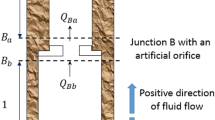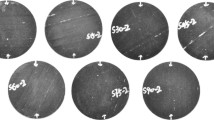Abstract
Wellbore collapse and drilling fluid leakage are prone to occur when drilling a conglomerate formation. The conventional method for predicting wellbore stability cannot achieve sufficient accuracy when used in conglomerate formations. In this study, the particle size distribution in the conglomerate formation is characterized by the statistics of particle size analysis. Based on microstructure analysis and laboratory tri-axial tests, physical and mechanical properties of conglomerate can be obtained. Discrete element method, by particle flow code software \(\hbox {PFC}^{2\mathrm{D}}\), is applied to simulate the failure process of the conglomerate formation near the borehole region and investigate the influence of gravel size distribution, drilling mud density and fluid infiltration on the severity of wellbore instability. The simulation results show that the process of wellbore instability within the conglomerate formation correlates with the particle size of the gravels and their spatial distribution: in the fine-grained conglomerate formation, the cracks dominantly extend toward the direction of maximum horizontal stress; in the coarse-grained conglomerate formation, the cracks initially generate around large gravels and preferentially extend toward the gravel-concentrated zone. In addition, the variation of drilling mud density substantially affects the number of cracks in terms of mechanical analysis. The favorable mud density for specific conglomerate formation is found to minimize crack numbers. Further, while considering fluid infiltration into formation, more cracks should be accounted and worse instability state is reached in comparison with counterpart without infiltration. In this sense, practical operations are recommended to allow for the pressure equilibrium and sealing capability of drilling fluid.
Similar content being viewed by others
References
Hou, B.; Chen, M.; Lu, Y.; et al.: Cause analysis of lost circulation and plugging method in Paleogene of Kuqa Piedmont structure. Oil Drill. Prod. Technol. 31(4), 40–44 (2009)
Friedman, G.M.: Classification of sediments and sedimentary rocks. In: Sedimentology. Encyclopedia of Earth Science, pp. 202–205. Springer, Berlin (1978)
Hellvik, S.; Nygaard, R.; Hoel, E.; et al.: PDC cutter and bit development for challenging conglomerate drilling in the Luno field-offshore Norway. In: IADC/SPE Drilling Conference and Exhibition. Society of Petroleum Engineers (2012)
Hou, B.; Jin, Y.; Li, S.; Zeng, C.: The mechanics of grain distribution on wellbore failure in conglomerate formation. Nat. Gas Ind. 35(11), 66–70 (2015)
Potyondy, D.; Autio, J.: Bonded-particle simulations of the in-situ failure test at Olkiluoto. In: DC Rocks 2001, The 38th US Symposium on Rock Mechanics (USRMS). American Rock Mechanics Association (2001)
Hashemi, S.S.; Momeni, A.A.; Melkoumian, N.: Investigation of borehole stability in poorly cemented granular formations by discrete element method. J. Pet. Sci. Eng. 113, 23–35 (2014)
Guo, M.: Investigation on drilling challenges of thick conglomerate formation in western china. J. Southwest Pet. Inst. 31(4), 40–44 (2006)
Zhang, J.: Study on drilling challenges of conglomerate formation in western district. Pet. Drill. Tech. 3(5), 84–89 (2006)
Hilgedick, S.A.; Nygaard, R.: Limitations of log-based wellbore stability analysis in an unconventional conglomerate-Rich reservoir in the Southern North Sea. ARMA 423(12), 254–259 (2012)
Hilgedick, S.A.; Nygaard, R.; Hellvik, S.; et al.: Geomechanical Wellbore Stability Analysis for Deviated Wells based on Vertical Exploration Data. AADE, Houston (2012)
Yue, Z.; Yang, R.; Sun, Z.; et al.: Test study on failure mechanism of the surrounding rock of inclined shaft in thick gravel stratum with abundant water (II). J. China Coal Soc. 35(8), 1274–1279 (2010)
Cundall, P.A.; Strack, O.D.L.: A discrete numerical model for granular assemblies. Geotechnique 29(1), 47–65 (1979)
Itasca Consulting Group: PFC2D user manuals (1999)
Holt, R.M.; Kjøaas, J.; Larsen, I.: Comparison between controlled laboratory experiments and discrete particle simulations of the mechanical behavior of rock. Int. J. Rock Mech. Min. Sci. 42, 985–995 (2005)
Holt, R.M.; Doornhof, D.; Kenter, C.J.: Use of discrete particle modeling to understand stress-release effects on mechanical and petrophysical behavior of granular rocks. In: Numerical Modeling in Micromechanics via Particle Methods. The 1st International PFC Symposium, Gelsenkirchen, Germany (2002)
Park, J.-W.; Song, J.-J.: Numerical simulation of a direct shear test on a rock joint using a bonded-particle model. Int. J. Rock Mech. Min. Sci. 46, 1315–1328 (2009)
Liu, N.; Zhang, C.; Zhu, W.; et al.: Microscopic characteristics analysis of brittle failure of deep buried marble. Chin. J. Rock Mech. Eng. 31(S2), 3557–3564 (2012)
Jiang, M.; Chen, H.; Liu, F.: A microscopic bond model for rock and preliminary study of numerical simulation method by distinct element method. Chin. J. Rock Mech. Eng. 31(1), 15–23 (2013)
Kang, Y.; Yu, M.; Miska, S.; et al.: Wellbore stability: a critical review and introduction to DEM. In: SPE Annual Technical Conference and Exhibition, New Orleans, Louisiana, USA (2009)
Huang, B.; Piper, J. D.; Qiao, Q.; et al.: Magnetostratigraphic and rock magnetic study of the Neogene upper Yaha section, Kuche Depression (Tarim Basin): implications to formation of the Xiyu conglomerate formation, NW China. J. Geophys. Res. Solid Earth 115, 3–5 (2010)
Wang, Y.; Liang, H.; Li, G.; et al.: Characteristics of gravel layer in DB Block Tarim and its affection of fasten drilling. Xinjiang Geol. 30(1), 113–115 (2012)
Leopold, L.B.: An improved method for size distribution of stream bed gravel. Water Resour. Res. 6(5), 138–166 (1970)
Polis, A.: Evaluation of Drill Cuttings for Determination of Formation Change using Particle-Size Analysis in a Water Test Well. Thesis San Diego State University, San Diego, California, (2015)
Akashi, M.; Otani, T.; Shimosaka, A.; et al.: Estimation of particle size distribution from cross-sectional particle diameter on the cutting plane. Adv. Powder Technol. 21(6), 676–680 (2010)
Li, L.; et al.: A numerical investigation of the hydraulic fracturing behaviour of conglomerate in Glutenite formation. Acta Geotech. 8(6), 597–618 (2013)
Liu, X.: Theoretical and application research on the fluid-rock coupling process and associated multi-scale behaviour. Doctoral thesis, Tshinghua University, Beijing (2008)
Lindquist, E.S.; Goodman, R.E.: Strength and deformation properties of a physical model melange. In: 1st North American Rock Mechanics Symposium. American Rock Mechanics Association (1994)
Jiang, H.; Chen, M.; Jin, Y.; et al.: Wellbore stability of the sandstone formation buried in high pressure and high temperature considering radial porous media flows of a compressible gas. In: 49th US Rock Mechanics/Geomechanics Symposium. American Rock Mechanics Association (2015)
Liang, C.; et al.: Wellbore stability model for shale gas reservoir considering the coupling of multi-weakness planes and porous flow. J. Nat. Gas Sci. Eng. 21, 364–378 (2014)
Cook, B.; Lee, M.; DiGiovanni, A.; et al.: Discrete element modeling applied to laboratory simulation of near-wellbore mechanics. Int. J. Geomech. 4(1), 19–27 (2004)
Ng, T.T.: Input parameters of discrete element methods. J. Eng. Mech. 132(7), 723–729 (2006)
Onate, E.; Rojek, J.: Combination of discrete element and finite element methods for dynamic analysis of geomechanics problems. Comput. Methods Appl. Mech. Eng. 193(27), 3087–3128 (2004)
Yoon, J.: Application of experimental design and optimization to PFC model calibration in uniaxial compression simulation. Int. J. Rock Mech. Min. Sci. 44(6), 871–889 (2007)
Guo, J.; et al.: Fast determination of meso-level mechanical parameters of PFC models. Int. J. Min. Sci. Technol. 23(1), 157–162 (2013)
Potyondy, D.O.: Simulating stress corrosion with a bonded-particle model for rock. Int. J. Rock Mech. Min. Sci. 44(5), 677–691 (2007)
Clark Jr, E. H.: Bottom-Hole Pressure Surges While Running Pipe. ASME Paper (54-PET), 22 (1955)
Burkhardt, J.A.: Wellbore pressure surges produced by pipe movement. J. Pet. Technol. 13(06), 595–605 (1961)
Author information
Authors and Affiliations
Corresponding author
Rights and permissions
About this article
Cite this article
Hou, B., Zeng, C., Chen, D. et al. Prediction of Wellbore Stability in Conglomerate Formation Using Discrete Element Method. Arab J Sci Eng 42, 1609–1619 (2017). https://doi.org/10.1007/s13369-016-2346-5
Received:
Accepted:
Published:
Issue Date:
DOI: https://doi.org/10.1007/s13369-016-2346-5




